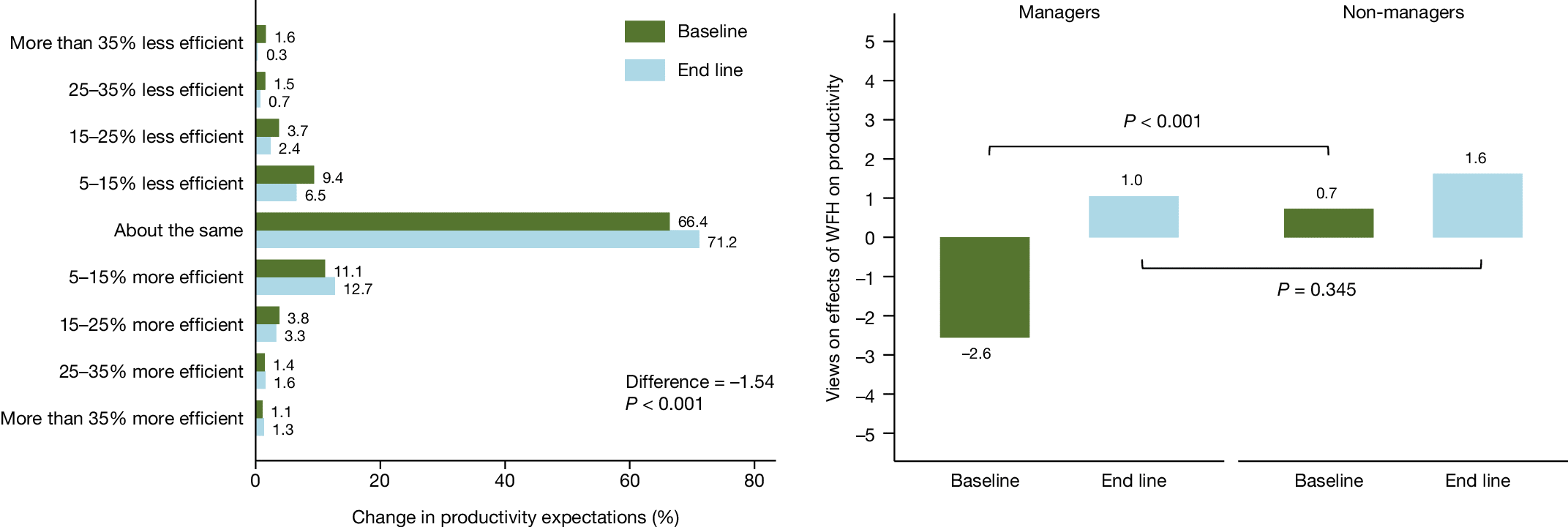The Impact of Hybrid Working on Employee Retention and Performance
Our six-month randomized control trial at Trip.com involving 1,612 employees revealed that hybrid working significantly improves job satisfaction and reduces attrition rates by one-third without harming performance. The study found no negative impact on performance reviews, promotion rates, or productivity. Managers’ perceptions of productivity also improved. These findings suggest that hybrid working can be a sustainable and beneficial model for organizations, enhancing retention and maintaining productivity.

The COVID-19 pandemic has accelerated a profound shift in work practices, leading to widespread adoption of remote and hybrid working models. This transformation has ignited a debate among academics, policymakers, and business leaders about the efficacy and sustainability of these new arrangements. Critics argue that remote work undermines productivity, hinders innovation, and negatively impacts career development (Barrero, Bloom, and Davis 2021; Emanuel and Harrington 2023). Concerns are also raised about potential isolation and the dilution of company culture (Yang et al., 2022). On the other hand, proponents of flexible working arrangements emphasize the benefits of improved work-life balance and enhanced job satisfaction, which can lead to increased employee retention (Mas and Pallais 2017; Choudhury, Foroughi, and Larson 2021). Also, the previous studies (Bloom et al. 2015; Emanuel and Harrington 2023; Yang et al. 2022) have all focused on call centers, data entry, and other jobs that are easy to measure, but are not really graduate jobs, so are less relevant for the hybrid discussion in 2024. About half of all university graduates are working on a hybrid schedule across the UK, Europe, and the US in 2024, typically three days in the office and two at home. So, evaluating the impact of this is critical. Our study aims to contribute to the above debate by providing empirical evidence on the impact of hybrid working on employee retention and performance through a six-month randomized control trial (RCT) at a major Chinese technology company. This is the first study that uses an RCT to examine the causal effect of hybrid schedule for graduates in professional jobs. By exploring both the potential benefits and drawbacks, we seek to offer a nuanced perspective on how hybrid work arrangements can be optimized for both employees and employers.
Methodology
Our research involved 1,612 employees from the Airfare and IT divisions of Trip.com, a leading travel technology firm headquartered in Shanghai. Employees were randomly assigned to either a hybrid working group, where they could work from home two days a week, or a control group, which continued to work from the office full-time. The primary goal was to evaluate how hybrid working affects job satisfaction, attrition rates, and overall performance.
Improved Job Satisfaction
The hybrid working arrangement significantly enhanced job satisfaction. Employees appreciated the flexibility to manage their schedules, save on commuting time and costs, and balance personal and professional responsibilities more effectively. This finding aligns with previous research indicating that employees highly value the work-life balance offered by remote work (Mas and Pallais 2017).
Reduced Attrition Rates
One of the most significant outcomes of the study was the reduction in attrition rates among the hybrid working group. Overall, quit rates dropped by one-third, with particularly notable reductions among non-managerial employees, female employees, and those with long commutes (Figure 1). These findings suggest that hybrid working can be an effective strategy for improving employee retention, which is crucial for companies facing high turnover costs (Allen 2008).
Figure 1: WFH cut attrition by 33% overall, and had a particularly strong effect for non-managers, women, and those with longer commutes.

One implication of the experimental design is that full enrollment into hybrid schemes is crucial due to concerns that volunteering may signal a lack of career ambition. This is particularly notable among female employees, who showed a low volunteer rate despite significant reductions in quit rates.
Performance Metrics
Crucially, as Figures 2 and 3 show, performance reviews and promotion rates remained consistent across both groups.
Figure 2: WFH had no significant effect on performance reviews over the next two years.

Figure 3: WFH had no significant effect on promotions over the next two years.

Furthermore, there was no significant difference in the lines of code written by software engineers, indicating that productivity levels were maintained. This result is important given that earlier studies suggest that remote work can damage employee development and promotions (Bloom et al. 2015; Emanuel and Harrington 2023; Yang et al. 2022).
Shift in Managerial Perceptions
Initially, managers were skeptical about the potential productivity impacts of hybrid working, expecting a negative effect. However, by the end of the experiment, as Figure 4 displays, their views had shifted positively, aligning more closely with the optimistic expectations of non-managers.
Figure 4: Views on the effect of WFH on productivity improved after the experiment, particularly for managers.

This change highlights the potential for experiential learning and adaptation among managers when exposed to hybrid working models. It also underscores the benefits of experimentation for firms in evaluating new working practices and technologies.
Organizational Benefits
The findings from our study suggest that hybrid working can be a sustainable and beneficial model for many organizations. By reducing attrition and maintaining performance levels, hybrid work arrangements can lead to significant cost savings and operational efficiencies. The standard numbers from HR professionals are that every quit costs the company about half of the person’s salary to recruit and retrain their replacement (Allen 2008). So, a one-third reduction in quit rates has a massive impact on boosting profits. Moreover, the enhanced job satisfaction associated with hybrid working can boost employee morale and engagement, further contributing to organizational success.
Policy Recommendations
For policymakers, the study offers valuable insights into the potential benefits of hybrid work models. Encouraging organizations to adopt flexible working arrangements could help address broader societal issues, such as traffic congestion and environmental sustainability, by reducing daily commutes. Additionally, hybrid working can provide a valuable amenity for employees, supporting work-life balance and potentially increasing overall workforce participation, particularly among groups such as women and individuals with caregiving responsibilities (Goldin 2022).
Future Research Directions
While our study provides robust evidence of the benefits of hybrid working, it also highlights areas for further research. Future studies should explore other arrangements of hybrid work, such as allowing employees to choose their work location on any given day, as these more flexible schemes would introduce more complexities due to factors such as the “coordination tax” (Smith 2024). Additionally, examining how hybrid work affects team dynamics, innovation, and company culture over extended periods would provide a more comprehensive understanding of its implications.
Conclusion
Our research contributes to the ongoing debate about the future of work by providing empirical evidence that hybrid working can improve employee retention and satisfaction without compromising performance. These insights are particularly relevant as organizations worldwide navigate the post-pandemic landscape and consider the future of work. By adopting hybrid models, companies can potentially enjoy the best of both worlds: retaining top talent and maintaining high productivity levels. This research underscores the importance of flexible working arrangements and offers valuable guidance for both policymakers and business leaders in shaping the future of work.
References
Allen, David G. 2008. “Retaining Talent: A Guide to Analyzing and Managing Employee Turnover.” Society for Human Resources Management. https://www.researchgate.net/publication/266223246_Retaining_Talent_-_A_guide_to_analyzing_and_managing_employee_turnover.
Barrero, Jose Maria, Nicholas Bloom, and Steven J. Davis. 2021. “Why Working from Home Will Stick.” National Bureau of Economic Research Working Paper No. 28731. https://doi.org/10.3386/w28731.
Bloom, Nicholas, Ruobing Han, and James Liang. 2024. “Hybrid Working from Home Improves Retention without Damaging Performance.” Nature 630: 920–25. https://doi.org/10.1038/s41586-024-07500-2.
Bloom, Nicholas, James Liang, John Roberts, and Zhichun Jenny Ying. 2015. “Does Working from Home Work? Evidence from a Chinese Experiment.” Quarterly Journal of Economics 130 (1): 165–218. https://doi.org/10.1093/qje/qju032.
Choudhury, Prithwiraj (Raj), Cirrus Foroughi, and Barbara Larson. 2021. “Work-from-Anywhere: The Productivity Effects of Geographic Flexibility.” Strategic Management Journal 42 (4): 655–83. https://doi.org/10.1002/smj.3251.
Emanuel, Natalia, and Emma Harrington. 2023. “Working Remotely? Selection, Treatment, and the Market for Remote Work.” American Economic Journal: Applied Economics (forthcoming).
Goldin, Claudia. 2022. “Understanding the Economic Impact of COVID-19 on Women.” National Bureau of Economic Research Working Paper No. 29974. https://doi.org/10.3386/w29974.
Mas, Alexandre, and Amanda Pallais. 2017. “Valuing Alternative Work Arrangements.” American Economic Review 107 (12): 3722–59. https://doi.org/10.1257/aer.20161500.
Whalen, J. R., and Ray A. Smith. “How Hybrid Work Schedules Can Result in a Coordination Tax.” Your Money Briefing (podcast), Wall Street Journal, June 17, 2024. https://www.wsj.com/podcasts/your-money-matters/how-hybrid-work-schedules-can-result-in-a-coordination-tax/674c57bc-0c6a-4c5c-945c-12da361bf8d2#:~:text=Ray%20Smith%20%3A%20A%20coordination%20tax,the%20same%20day%20in%20advance.
Yang, Longgi, David Holtz, Sonia Jaffe, Siddharth Suri, Shilpi Sinha, Jeffrey Weston, Connor Joyce, Neha Shah, Kevin Sherman, Brent Hecht, and Jaime Teevan. 2022. “The Effects of Remote Work on Collaboration among Information Workers.” Nature Human Behaviour 6: 43–54. https://doi.org/10.1038/s41562-021-01196-4.

Latest
Most Popular
- VoxChina Covid-19 Forum (Second Edition): China’s Post-Lockdown Economic Recovery VoxChina, Apr 18, 2020
- China’s Great Housing Boom Kaiji Chen, Yi Wen, Oct 11, 2017
- China’s Joint Venture Policy and the International Transfer of Technology Kun Jiang, Wolfgang Keller, Larry D. Qiu, William Ridley, Feb 06, 2019
- The Dark Side of the Chinese Fiscal Stimulus: Evidence from Local Government Debt Yi Huang, Marco Pagano, Ugo Panizza, Jun 28, 2017
- Wealth Redistribution in the Chinese Stock Market: the Role of Bubbles and Crashes Li An, Jiangze Bian, Dong Lou, Donghui Shi, Jul 01, 2020
- What Is Special about China’s Housing Boom? Edward L. Glaeser, Wei Huang, Yueran Ma, Andrei Shleifer, Jun 20, 2017
- Evaluating Risk across Chinese Housing Markets Yongheng Deng, Joseph Gyourko, Jing Wu, Aug 02, 2017
- Privatization and Productivity in China Yuyu Chen, Mitsuru Igami, Masayuki Sawada, Mo Xiao, Jan 31, 2018
- How did China Move Up the Global Value Chains? Hiau Looi Kee, Heiwai Tang, Aug 30, 2017
- China’s Shadow Banking Sector: Wealth Management Products and Issuing Banks Viral V. Acharya, Jun Qian, Zhishu Yang, Aug 09, 2017




 Facebook
Facebook  Twitter
Twitter  Instagram
Instagram WeChat
WeChat  Email
Email 


